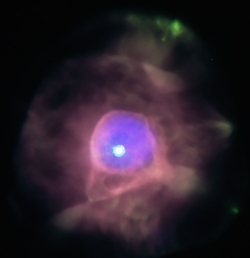HEAPOW: Old Star Blowing Bubbles (2020 Nov 16)
Posted: Mon Nov 16, 2020 3:10 pm
 HEAPOW: Old Star Blowing Bubbles (2020 Nov 16)
HEAPOW: Old Star Blowing Bubbles (2020 Nov 16)
Stars like the Sun create energy in their cores by fusing hydrogen into helium. This process of thermonuclear fusion is a steady process which allows these stars to shine stably for billions of years, time enough to give advanced life forms the possibility of evolving. But at some point such stars run out of fuel. This will happen to our Sun in about 5 billion years from now. Near the end of its nuclear burning life, the star expands to a few hundred times its former size, and begins to lose its outer atmosphere, which drifts away from the star and forms a visually stunning structure called a planetary nebula (another in a long list of astronomical misnomers, since the ejected gas and dust has no direct connection to planets or planet formation). The central remnant of the core of the star eventually becomes visible as a glowing, hot, earth-sized, dense white dwarf. Because this central "star" is initially so hot when it first appears (having surface temperatures about 5 to 10 times hotter than the temperature of the living star), it produces an enormous amount of energetic ultraviolet radiation. This radiation packs quite a punch and powers a strong stellar wind which blows outward from the star at speeds of millions of miles per hour. This powerful wind eventually catches up to and supersonically collides with the slow moving material in the planetary nebula, converting kinetic energy to heat, raising temperatures of the shock-heated gas to millions of degrees, forming a wind-blow bubble glowing in X-rays. The image above is an optical image from the Hubble Space Telescope of a planetary nebula called IC 4593. The X-ray emission from IC 4593 as seen by the Chandra X-ray Observatory is shown in purple. The X-ray emission seen by Chandra shows the bubble of hot, million-degree gas produced by the strong collision between the wind from the central star and the matter in the planetary nebula. This hot bubble is more than 10 times the size of Pluto's orbit.
| << Previous HEAPOW | High Energy Astrophysics Picture of the Week | Next HEAPOW >> |

